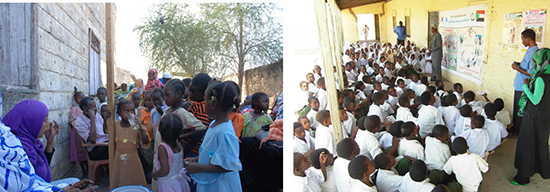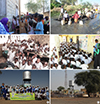3. Neglected tropical diseases: no longer someone else's problem. Lancet Infect Dis. 2014; 14:899.
4. Hong ST, Chai JY, Choi MH, Huh S, Rim HJ, Lee SH. A successful experience of soil-transmitted helminth control in the Republic of Korea. Korean J Parasitol. 2006; 44:177–185.
5. Korea Centers for Diseases Control and Prevention. Korea Association of Health Promotion. Prevalence of intestinal parasites in Korea: the 8th report. Osong: Korea Centers for Diseases Control and Prevention;2013.
6. Addiss D. Global Alliance to Eliminate Lymphatic Filariasis. The 6th meeting of the global alliance to eliminate lymphatic filariasis: a half-time review of lymphatic filariasis elimination and its integration with the control of other neglected tropical diseases. Parasit Vectors. 2010; 3:100.
7. Korea Association of Health Promotion. Korea International Cooperation Agency. Final report on the Korea-China collaborative project of control strategies for helminthiasis in pilot areas (2000-2004). Seoul: Korea Association of Health Promotion;2004.
8. Korea Association of Health Promotion. Control activities for parasitic infections by Korea Assoication of Health Promotion, 2013. Seoul: Korea Association of Health Promotion;2014.
9. Good Neighbors. Good Neighbors NTDs control program in Tanzania and future of public health projects by Korean NGOs. Seoul: Good Neighbors;2014.
10. Korea National Institute of Health. Korea Centers for Disease Control and Prevention. National documentation for certification: elimination of lymphatic filrariasis in Korea. Seoul: Korea National Institute of Health;Korea Centers for Disease Control and Prevention;2007.
11. Cheun HI, Lee JS, Cho SH, Kong Y, Kim TS. Elimination of lymphatic filariasis in the Republic of Korea: an epidemiological survey of formerly endemic areas, 2002-2006. Trop Med Int Health. 2009; 14:445–449.
13. Simonsen PE. Filariasis. In : Cook GC, Zumla AI, editors. Manson's Tropical Diseases. 22th ed. China: Elsevier;2009. p. 1477–1513.
14. Ichimori K, King JD, Engels D, Yajima A, Mikhailov A, Lammie P, Ottesen EA. Global programme to eliminate lymphatic filariasis: the processes underlying programme success. PLoS Negl Trop Dis. 2014; 8:e3328.
15. Ottesen EA, Hooper PJ, Bradley M, Biswas G. The global programme to eliminate lymphatic filariasis: health impact after 8 years. PLoS Negl Trop Dis. 2008; 2:e317.
16. World Health Organization. Lymphatic filariasis-progress report 2000-2009 and strategic plan 2010-2020 of the global programme to eliminate lymphatic filariasis: halfway towards eliminating lymphatic filariasis. Geneva: World Health Organization;2010.
18. Bethony J, Brooker S, Albonico M, Geiger SM, Loukas A, Diemert D, Hotez PJ. Soil-transmitted helminth infections: ascariasis, trichuriasis, and hookworm. Lancet. 2006; 367:1521–1532.
19. Truscott J, Hollingsworth TD, Anderson R. Modeling the interruption of the transmission of soil-transmitted helminths by repeated mass chemotherapy of school-age children. PLoS Negl Trop Dis. 2014; 8:e3323.
20. World Health Organization. Eliminating soil-transmitted helminthiasis as a public health problem in children: Progress report 2001-2010 and strategic plan 2011-2020. Geneva, Switzerland: WHO Press;2012.
21. Mascarini-Serra L. Prevention of Soil-transmitted Helminth Infection. J Glob Infect Dis. 2011; 3:175–182.
22. Yap P, Früst T, Müller I, Kriemler S, Utzinger J, Steinmann P. Determining soil-transmitted helminth infection status and physical fitness of school-aged children. J Vis Exp. 2012; e3966.
25. Etya'ale D. Onchocerciasis and trachoma control: what has changed in the past two decades? Community Eye Health. 2008; 21:43–45.
28. Fenwick A. The global burden of neglected tropical diseases. Public Health. 2012; 126:233–236.
29. Davis A. Schistosomiasis. In : Cook GC, Zumla AI, editors. Manson's Tropical Diseases. 22th ed. China: Elsevier;2009. p. 1425–1460.
30. Lee YH, Jeong HG, Kong WH, Lee SH, Cho HI, Nam HS, Ismail HA, Alla GN, Oh CH, Hong ST. Reduction of urogenital schistosomiasis with an integrated control project in Sudan. PLoS Negl Trop Dis. 2015; 9:e3423.
31. Cairncross S, Tayeh A, Korkor AS. Why is dracunculiasis eradication taking so long? Trends Parasitol. 2012; 28:225–230.
33. Al-Awadi AR, Al-Kuhlani A, Breman JG, Doumbo O, Eberhard ML, Guiguemde RT, Magnussen P, Molyneux DH, Nadim A. Guinea worm (Dracunculiasis) eradication: update on progress and endgame challenges. Trans R Soc Trop Med Hyg. 2014; 108:249–251.
35. Ready PD. Epidemiology of visceral leishmaniasis. Clin Epidemiol. 2014; 6:147–154.
36. Barrett MP, Croft SL. Management of trypanosomiasis and leishmaniasis. Br Med Bull. 2012; 104:175–196.
37. Heu I. Three cases of Kala-azar, especially on the various serologic reaction. Korean J Intern Med. 1952; 1:118–121.
38. Chi JG, Shong YK, Hong ST, Lee SH, Seo BS, Choe KW. An imported case of kala-azar in Korea. Korean J Parasitol. 1983; 21:87–94.
39. Ahn MH. Imported parasitic diseases in Korea. Infect Chemother. 2010; 42:271–279.
40. Kim HY, Jung SE, Park KW, Kim WK. Visceral leishmaniasis in a child. J Korean Assoc Pediatr Surg. 2004; 10:35–38.
41. Bhang DH, Choi US, Kim HJ, Cho KO, Shin SS, Youn HJ, Hwang CY, Youn HY. An autochthonous case of canine visceral leishmaniasis in Korea. Korean J Parasitol. 2013; 51:545–549.
44. Barrett MP, Burchmore RJ, Stich A, Lazzari JO, Frasch AC, Cazzulo JJ, Krishna S. The trypanosomiases. Lancet. 2003; 362:1469–1480.
45. Brun R, Blum J, Chappuis F, Burri C. Human African trypanosomiasis. Lancet. 2010; 375:148–159.







 PDF
PDF Citation
Citation Print
Print



 XML Download
XML Download